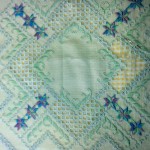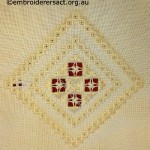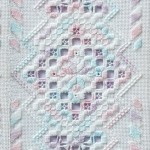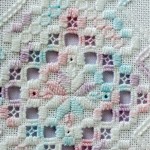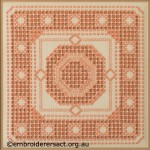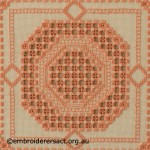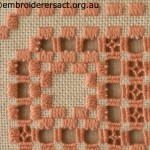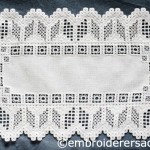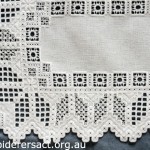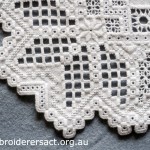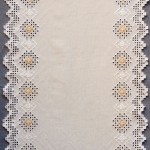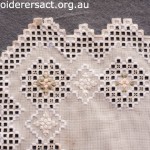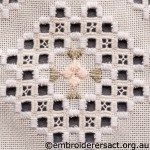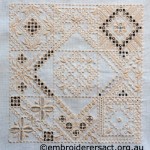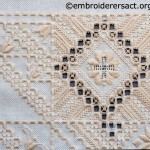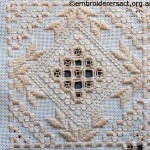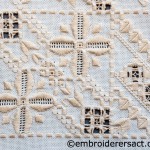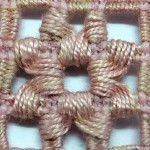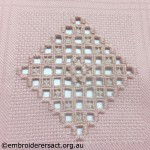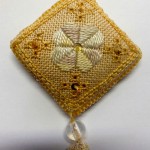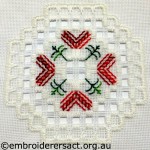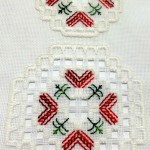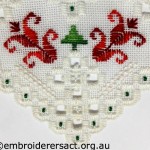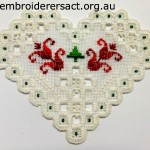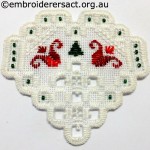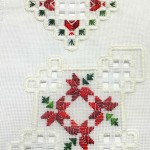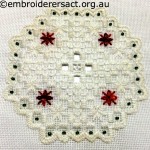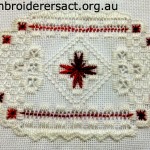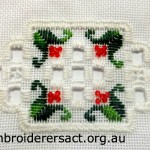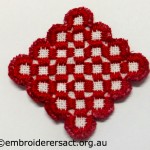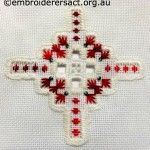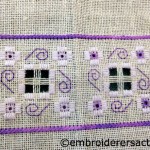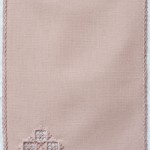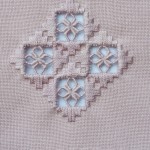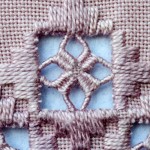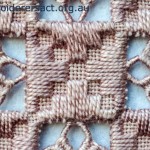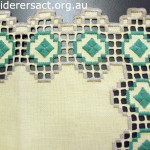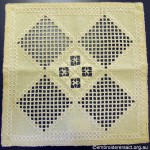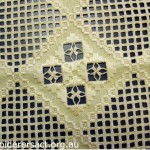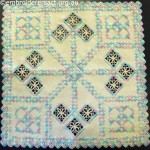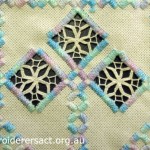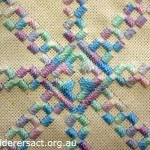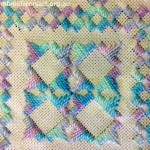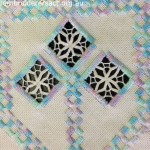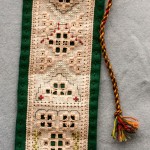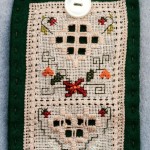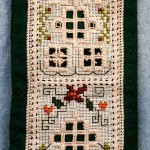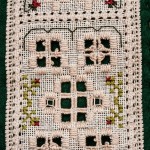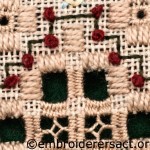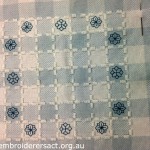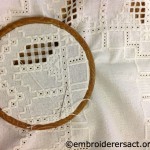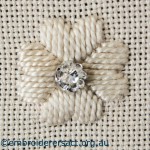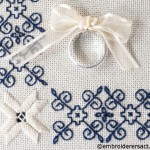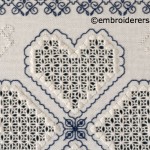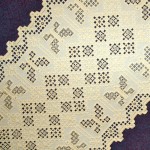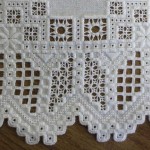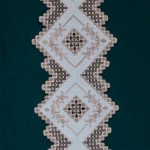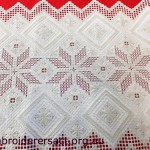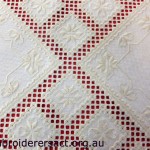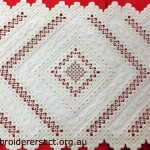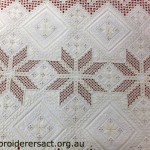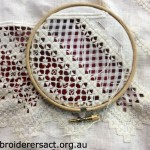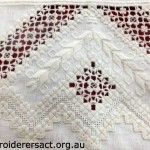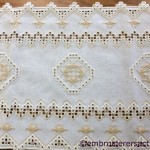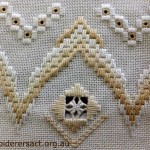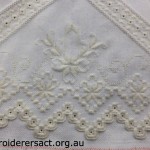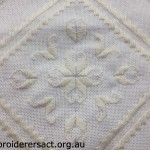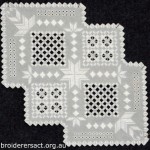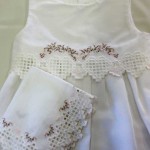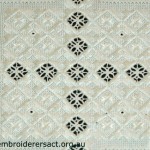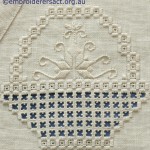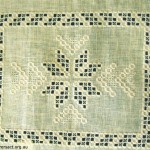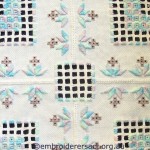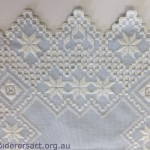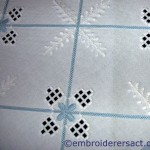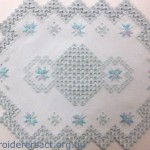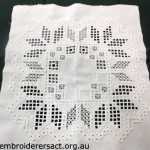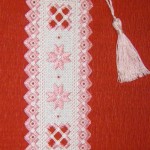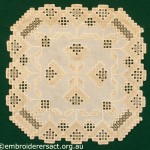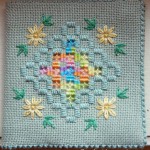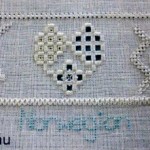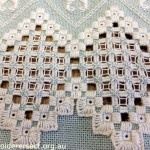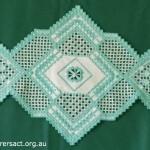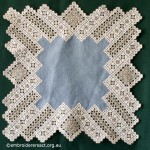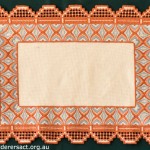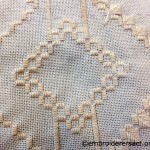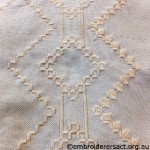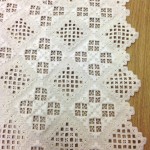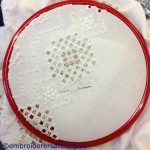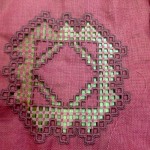History
The home of this embroidery technique is the Hardanger Fjiord in South West Norway – you can see where it’s located on a Google map here. It looks like a beautiful place:
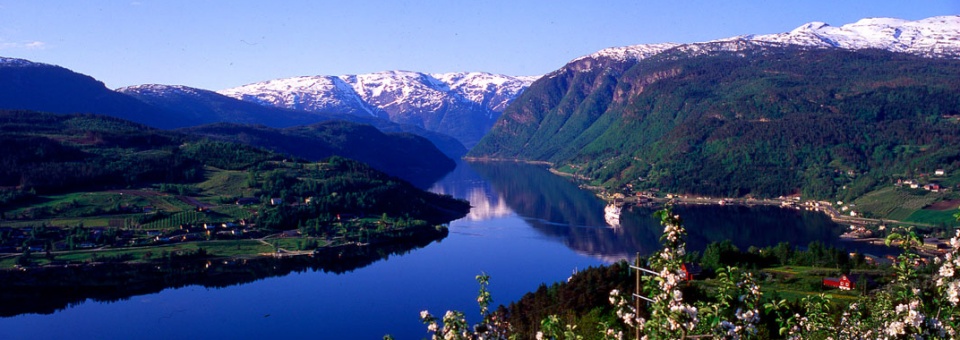
Up until recently the historical thinking had been that Hardanger had its origins in Persian designs and came to Norway via Italian techniques such as Reticella and Venetian Lace in the Middle Ages. Earlier silks with Persian patterns were thought to have been part of the loot gathered in Viking raids in England and Europe.
However there’s been recent research done by Associate Professor Marianne Vedeler at the University of Oslo that’s shedding new light on the history of Hardanger. Her research suggests that the silk trade in the Viking era was much more extensive than previously assumed and that they traded regularly with the Persian and Byzantine empires.
One of the most important sources of Viking era silks is the Oseberg ship – a well preserved Viking ship found in a burial mound at Oseberg farm near Tonsberg in Norway. The treasures found on this ship include silk from 15 different textiles, embroideries and tablet woven silk and wool bands. The silk textiles include Persian patterns. You can read more about Professor Vedeler’s research here
Hardanger Technique
Hardanger is Whitework that’s based on a counted thread technique combined with drawn threadwork and needleweaving. The patterns and motifs are geometric but the angular quality of the designs is softened by the cutting and needleweaving which create a lacy effect. It’s stitched on even weave fabric usually 22 count.
It’s thought that the relative isolation of the Hardanger Fjiord is the main reason this very distinctive style evolved. Traditionally it was (and continues to be) stitched as white on white and was used in the folkloric costumes or bunards of the region as well as to decorate homewares.
It became known worldwide when an apron with Hardanger embroidery won an award at the Paris Exposition in 1900. The needlewoman was Brita Skalveit of Aga in the Hardanger district.
Contemporary Hardanger includes colourwork and you can see examples of both the Whitework and Colourwork styles on our Hardanger Gallery.
- Hardanger Acqua and Mauve Piece in progress stitched by Avis Gesling
- Hardanger Diamond in Progress stitched by Trish Hyland
- Box with Hadanger Lid stitched by Elvi McCann
- Detail 1 of Box with Hardanger Lid stitched by Elvi McCann
- Detail 2 of Box with Hardanger Lid stitched by Elvi McCann
- Hardanger Square stitched by Kay Reid
- Detail 1 of Hardanger Square stitched by Kay Reid
- Detail 2 of Hardanger Square stitched by Kay Reid
- Hardanger Fower Girl by Irene Burton
- Detail 1 of Hardanger Flower Girl by Irene Burton
- Detail 2 of Hardanger Flower Girl by Irene Burton
- Detail 3 of Hardanger Flower Girl by Irene Burton
- Detail 4 of Hardanger Flower Girl by Irene Burton
- Detail 5 of Hardanger Flower Girl by Irene Burton
- Detail 6 of Hardanger Flower Girl by Irene Burton
- Hardanger Table Runner stitched by Meryl Fellows
- Detail 1 of Hardanger Table Runner stitched by Meryl Fellows
- Detail 2 of Hardanger in Progress stitched by Meryl Fellows
- Hardanger Table Runner stitched by Lesley Jemesen
- Detail of Hardanger Table Runner stitched by Lesley Jemesen
- Detail 2 of Hardanger Table Runner stitched by Lesley Jemesen
- Detail 4 of Hardanger Table Runner stitched by Lesley Jemesen
- Hardanger in progress stithed by Jillian Bath
- Detail 1 of Hardanger in Progress stitched by Jillian Bath
- Detail 2 of Hardanger in Progress stitched by Jillian Bath
- Detail 4 of Hardanger in Progress stitched by Jillian Bath
- Sunflower motif stitched by Brenda Phillips
- Pink Hardanger Diamond with Sunflower Motif stitched by Brenda Phillips
- Close up of Hardanger Scissorskeep by Brenda Phillips
- Hardanger Scissorskeep by Brenda Phillips
- Close up of Ornament 12 stitched by Jillian Bath
- Hardanger Christmas Ornament No.12 stitched by Jillian Bath
- Hardanger Christmas Ornament No 11 stitched by Jillian Bath
- Hardanger Christmas Ornament 10 stitched by Jillian Bath
- Hardanger Christmas Ornament 9 stitched by Jillian Bath
- Hardanger christmas Ornament 8 stitched by Jillian Bath
- Hardanger Christmas Ornament 7 stitched by Jillian Bath
- Hardanger Christmas Ornament 5 stitched by Jillian Bath
- Christmas Ornament 4 stitched by Jillan Bath
- Christmas Ornament 3 stitched by Jillian Bath
- Christmas Ornament 2 stitched by Jillian Bath
- Hardanger Red Diamond stitched by Jillian Bath
- Hardanger Cross stitched by Jillian Bath
- Hardanger in Progress stitched by Jillian Bath
- Pink Hardanger Mat by Marjorie Gilby
- Hardanger Motif on Pink Mat stitched by Marjorie Gilby
- Close up of Hardanger Motif by Marjorie Gilby
- Close up 2 from Pink Hardanger Mat stitched by Marjorie Gilby
- Guild Hardanger Sample stitched by Bonnie Crawford
- Green Diamonds stitched by Levona Lea
- Corner of Hardanger Square with Green Diamonds stitched by Levona Lea
- White Hardanger Square stitched by Levona Lea
- Detail of Central Motif in White Hardanger Square by Levona Lea
- Pink and Acqua Hardanger Square by Levona Lea
- Detail of motif on Pink and Acqua Hardanger Square by Levona Lea
- Detail from Pink and Acqua Hardanger Square by Levona Lea
- Detail 3 of Acqua and Pink Hardanger Square stitched by Levona Lea
- Detail 4 of Acqua and Pink Hardanger Square stitched by Levona Lea
- Hardanger Needle Roll stitched by Jillian Bath
- Top end of Hardanger Needle Roll stitched by Jillian Bath
- Hardanger Needle Roll rolled out stitched by Jillian Bath
- Detail 1 of Hardanger Needle Roll stitched by Jillian Bath
- Detail 2 of Hardanger Needle Roll stitched by Jillian Bath
- Detail 3 of Hardanger Needle Roll stitched by Jillian Bath
- Detail 4 of Hardanger Needle Roll stitched by Jillian Bath
- Detail 6 from Hardanger Needle Roll stitched by Jillian Bath
- Hardanger and Blackwork in progress by Cathy Fetherston
- Hardanger Angel by Sharon Burrell
- Hardanger Diamond in Progress stitched by Trish Hyland
- Hardanger in hoop stitched by Meryl Fellows
- Janet Pearce Blackwork & Hardanger Ring Cushion
- Janet Pearce – Flower detail of Wedding Sampler
- Janet Pearce – bottom left hand corner of Wedding sampler
- Janet Pearce – Top half of wedding sampler
- Janet Pearce Blackwork & Hardanger Ring Cushion
- Hardanger Doll by Irene Burton
- Detail of Hardanger Doyley stitched by Bonnie Crawford
- Hardanger Table Runner with Butterfly Motif stitched by Bonnie Crawford
- Hardanger Pattern from A Stitches Dream by Mildred Torgesson Stitched by Meryl Fellows
- Diamonds Hardanger Runner stitched by Shirley Eaton
- Hardanger Angel by Brenda Phillips
- Detail of Hardanger Ivory Runner stitched by Meryl Fellows
- Detail of Diamond Hardanger stitched by Meryl Fellows
- Diamond White Hardanger by Avis Gesling
- Three Stars & Diamonds Hardanger by Avis Gesling
- Hardanger Needlelace in hoop by Doreen McGregor
- Hardanger Needelace detail by Doreen McGregor
- Detail of Hardanger Runner stitched by Anne Dowling
- Bargello and Hardanger Runner by Anne Dowling
- Hardanger edge by Avis Gesling
- Detail 2 of Hardanger Diamond motif by Avis Gesling
- Hardanger by Avis Gesling
- Hardanger Table Centre by Gloria Steptoe
- Jemima Hardanger Runner stitched by Anne Dowling
- Baby and Bride Christening Gown detail Hardanger and cross stitch Stitched by Brenda Phillips
- Baby and Bride Christening Gown. Hardanger and cross stitch Stitched by Brenda Phillips
- Detail Hardanger Doyley stitched by Gloria Steptoe
- Hardanger basket from the Guild’s banner
- Hardanger cloth. Held in Guild’s Collection
- Bargello and Hardanger Runner by Meryl Fellows
- Detail of Doyley with Flowers & Hardanger
- Acqua and White Hardanger Doyley by Bonnie Crawford
- Acqua Hardanger with 3 Flowers by Avis Gesling
- Detail of Blue & White Hardanger Square by Anne Dowling
- Blue & White Hardanger tablecloth by Elvi McCann
- Hardanger Doyley by Bonnie Crawford
- Acqua Diamond Hardanger by Avis Gesling
- Detail of Hardanger Tray Cloth stitched by Anne Lond
- Hardanger rectangle in progress by Meryl Fellows
- Hardanger Bookmark by Irene Burton
- Hardanger Square Doiley by Shirley Eaton
- Hardanger Doyley by Christine Bailley
- Hardanger Needlecase stitched by Avis Gesling
- Hardanger Needlecase with Flowers stitched by Avis Gesling
- Birthday Hardanger & Back Stitch Square stitched by Elvi McCann
- Hardanger Octagon by Marion Hendy
- Detail of Hardanger embroidery on Whitework Sampler stitched by Jan Hure
- Hardanger Runner in soft sage colour stitched by Ann Lond.
- Acqua Green & Cream Hardanger stitched by Christine Bailey
- Blue and Cream Hardanger stitched by Christine Bailey
- Bargello & Hardanger Mat stitched by Christine Bailey



